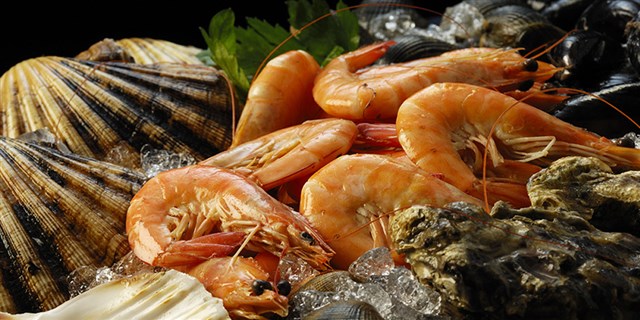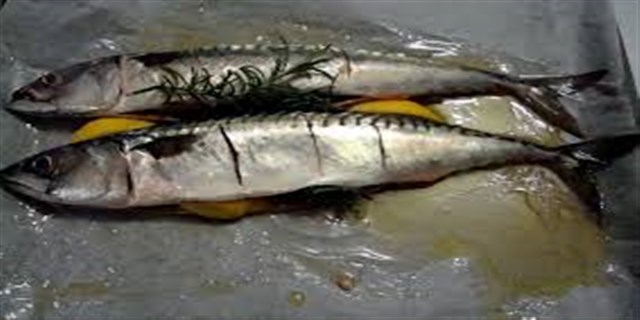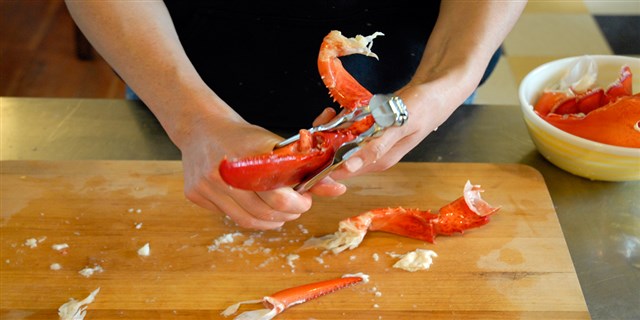Most of the preparation of fish can be done before it reaches the kitchen. It is worth finding a supplier who will prepare the fish just as you want it. Besides that, a few basic skills will help you get the most from this nutritious food.
Cooking Fish At Home
Fresh fish needs little preparation, and if it is bought already filleted or skinned it can be considered a ready-to-cook convenience food. Frozen fish can usually be used as a substitute for fresh fish. If possible, cook straight from frozen to retain all the juices and flavor.
Scaling Fish; Rinsing under water Hold fish under cold water while removing scales, washing them away as you scrape.
Using a Scallop Shell
Remove all the scales from a whole fish with the edge of a scallop shell, scraping firmly down the length of the fish from the tail end toward the head.
Removing Bones:
Boning cooked fish: When flaking fish, check for small bones after cooking, when they can be removed easily.
Using Tweezers: Use tweezers to pluck out stray bones left in fish fillets after filleting. Press gently with your fingertips to feel for the small bones under the surface.
Filleting Fish
Filleting flat fish Fillet flatfish without gutting it there is no danger of the gut being pierced and contaminating the flesh.
Boning Mackerel
To bone mackerel, slit open the belly, and place the fish skin side up. Press firmly with your thumbs down the backbone. Turn over, and lift out the bones.
Cleaning and Skinning
• Preventing mess: To scale a whole fish cleanly, place it in a large heavy plastic bag, and scrape off the scales inside it.
• Using salt: Dip fingertips into salt before skinning fish to give a better grip. Also, rub salt inside the belly cavity to remove any residues, then rinse well before cooking.
• Skinning frozen fish: Pull the skin from frozen fillets while still frozen. Use paper towels to help you grip the skin.
• Removing fishy smells: Rub the cut surface of a lemon over hands, knife, and cutting board after preparing fish to counteract fishy odors.
Preparing a Whole Fish
Trimming the Tail
If you are preparing a whole fish, such as salmon or trout, to serve with its tail on, trim the thin edges of the tail with scissors to make a V shape. This will prevent the tail from curling up in the heat during cooking.
• Trimming the fins: Use kitchen scissors to snip the fins off a whole fish before cooking.
• Cleaning through the gills: To preserve the shape of the fish that is to be served whole, remove the stomach contents of the fish through the gill flaps instead of slitting open the belly.
• Removing the gills: If a fish is to be cooked and served with the head intact, snip out the gills with scissors first, since they can impart a bitter taste.
• Removing the head: To remove the head from a whole fish, cut following the natural curve behind the gills.
Cooking Shellfish At Home
Much of the fresh shellfish we eat is sold in the shell and is often live, so preparation must be done at home. Live shellfish, such as oysters, mussels, and clams, are best prepared just before you serve them to ensure maximum freshness and safety, as well as the best results.
Cleaning and Serving
• Debearding mussels: Remove beards from mussels just before cooking, since they die once the beards are removed.
• Using crushed ice: Prepare a serving platter with crushed ice before opening oysters, so that the shells can be firmly nestled in and the juices remain in the shells.
• Chilling shellfish: Put clams or oysters, unopened, in the freezer for 10 minutes before serving; they will open easily.
• Serving in shells: When buying shelled scallops, ask for the curved shells so that you can use them as serving dishes. Scrub and boil to clean.
Cracking Crab Claws
To crack a crab claw without shattering it, cup it in the palm of your hand, and tap with a small hammer until the shell cracks. Alternatively, crack the claw on a folded dishtowel on a cutting board.
Opening Oysters
• Using the oven: Place oysters in one layer on a cookie sheet, and put in a hot oven for 3-4 minutes until they open.
Open oyster shells with the pointed tip of a can opener. Grasp each shell firmly in a cloth, holding the flat side upward, then insert the opener into die hinge and push down firmly.
Crustaceans
Fresh shrimp, lobsters, and other crustaceans are usually sold in the shell, and a few simple skills are needed to prepare them. Do not be deterred by this preparation, which is speedy and worthwhile. The flavor of fresh crustaceans is better than peeled, frozen, or canned products.
Using Scissors
To devein large shrimp before cooking, cut along the back of each shell. It is easy to see the dark vein running down the back. Lift out the vein carefully, or scrape it out with a knife.
Dealing With Shells
• Peeling easily: To peel cooked shrimp, grasp the head between finger and thumb, and twist to remove. Pull the legs to one side; as they break away, part of the shell should lift off. You will be able to peel it all off.
• Cutting shells: Use kitchen scissors or poultry shears to cut lobster shells in half easily.
• Wiping edges: After cutting lobster or crayfish shells in half for serving, wipe around the edges of the cut shells with a clean, damp cloth to remove small fragments.
• Serving in shells: To serve lobster attractively in the shell, lift out the tail flesh from each half and replace it, rounded side up, in the opposite half.
Using Shells
• Use shells to add color and flavor to stocks, sauces, and other accompaniments.
Making fish stock; After boiling the lobster and scooping out the meat, return the shell pieces to the cooking liquid, and add a glass of white wine, a few onion slices, and a bouquet, garlic. Simmer for 20 minutes, then strain.
• Making a fish sauce: Grind lobster shells in a food processor until smooth. Cook in a little butter, then add white wine and cream to make a rich sauce for white fish.
• Making shrimp butter: Puree equal amounts of shrimp shells and butter with a little lemon juice in a food processor.







